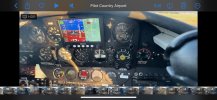It'll be a cold day in hell when I buy another certified aircraft.
I wasn't planning on doing any avionics work on my Nanchang for the first year. But that plan has already gone up in smoke.
The AI that came in the plane was an odd one made in Italy and it's not well supported, so that was bugging me. Then on Wednesday I had my transponder test done and during the test my transponder caught on fire. Melted down right quick. Fortunately it was all internal and the plane was fine. But now I had to either replace the decrepit GTX-320, or rewire for another used transponder which my IA has a pile of, or upgrade it, also requiring a rewire.
So all day Wednesday and half of Thursday I went back and forth trying to decide what to do. Decided to go forward instead of staying in Stone Age. Ordered a Sandia Remote Transponder and a GRT Sport EX EFIS to control it with and replace my old AI. Paid an extra $60 to get it over-nighted.
They arrived on Friday, and I removed the entire pilots panel, cut the hole for the EFIS, mounted the EFIS and replaced the other instruments, mounted the new transponder, wired them together, and wired the EFIS to the intercom for audio alerts.
Got it all done and tested by late this afternoon. From "stuff is broke, what the heck am I going to do" to "flying" in 4 days. I'd still be talking to an avionics shop about my options on a certified plane. Actually, I'd probably be still trying to get an avionics shop to answer my call.
The equipment has most everything a Garmin would, and a few things Garmin doesn't. And no way I could have gotten it all working so quickly.

I wasn't planning on doing any avionics work on my Nanchang for the first year. But that plan has already gone up in smoke.
The AI that came in the plane was an odd one made in Italy and it's not well supported, so that was bugging me. Then on Wednesday I had my transponder test done and during the test my transponder caught on fire. Melted down right quick. Fortunately it was all internal and the plane was fine. But now I had to either replace the decrepit GTX-320, or rewire for another used transponder which my IA has a pile of, or upgrade it, also requiring a rewire.
So all day Wednesday and half of Thursday I went back and forth trying to decide what to do. Decided to go forward instead of staying in Stone Age. Ordered a Sandia Remote Transponder and a GRT Sport EX EFIS to control it with and replace my old AI. Paid an extra $60 to get it over-nighted.
They arrived on Friday, and I removed the entire pilots panel, cut the hole for the EFIS, mounted the EFIS and replaced the other instruments, mounted the new transponder, wired them together, and wired the EFIS to the intercom for audio alerts.
Got it all done and tested by late this afternoon. From "stuff is broke, what the heck am I going to do" to "flying" in 4 days. I'd still be talking to an avionics shop about my options on a certified plane. Actually, I'd probably be still trying to get an avionics shop to answer my call.
The equipment has most everything a Garmin would, and a few things Garmin doesn't. And no way I could have gotten it all working so quickly.



 How does the plane actually fly?
How does the plane actually fly?